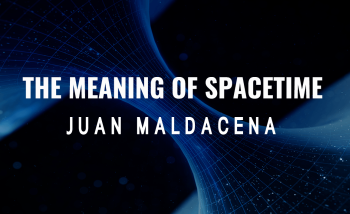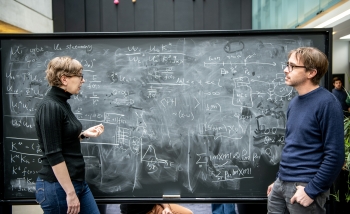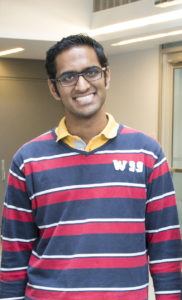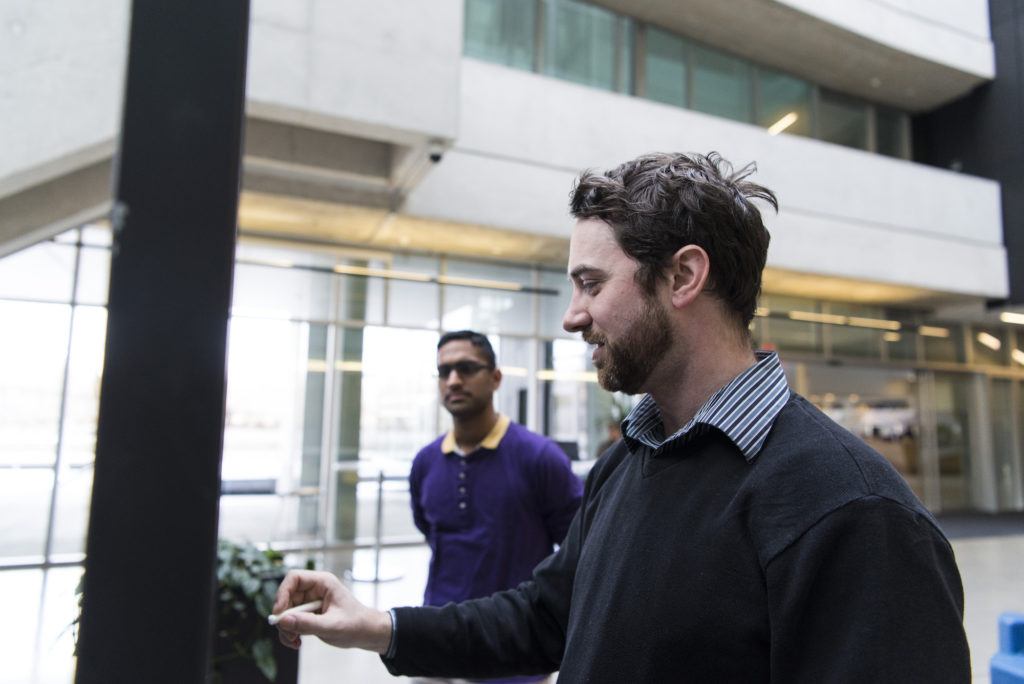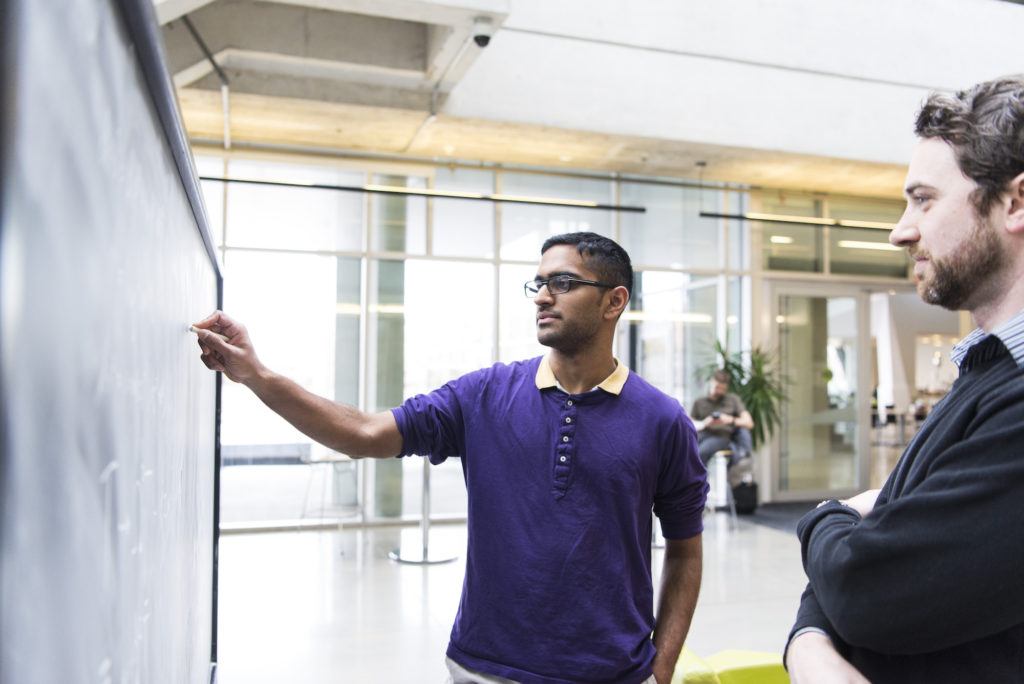Vasudev Shyam is no stranger to a tough navigation problem.
The Perimeter PhD candidate is originally from Bangalore, India. He spent his early adolescence bored and underperforming, lacking access to elite schools or other enrichment opportunities. What he did have was the internet.
Shyam took his education into his own hands, spending countless hours watching physics lectures online, including those offered from Perimeter. He reached out to Perimeter faculty with some early research and was admitted to the Perimeter Scholars International (PSI) master’s program at the age of 18.
Now 23 and on the cusp of defending his PhD thesis, Shyam is again mapping uncharted territory, investigating the properties of a recently discovered class of peculiar quantum field theories. To do so, he’s making use of a concept known as holography – a tool that links theories that, at first glance, appear to be unrelated.
Found in translation
Modern physics is fluent in two languages: the language of gravity and the language of fields. Gravitational theories talk about space and time. Quantum field theories describe forces, particles, and fields – essentially all the non-gravitational phenomena in physics. Holography translates from one language to the other.
In particular, holography translates gravitational theories into field theories (or vice versa) by fiddling with the number of dimensions involved. Generally, a gravitational theory describing a particular spacetime is translated into a field theory that lives on the boundary of the spacetime. It’s as if the gravitational theory describes the space inside a balloon and the field theory describes what’s happening on the balloon’s skin.
Theories that are equivalent to each other in this matter are known as “duals.” Physicists can use these dualities to transfer complex or intractable problems in one area of physics to more manageable problems in another.
The most studied of these holographic dualities is between a certain kind of spacetime, called anti-de Sitter (or AdS) spacetime, and a particular type of quantum field theory, known as a conformal field theory, that lives on the boundary of the spacetime. This is known as the AdS/CFT correspondence.
Over the past several decades, the AdS/CFT correspondence has proven incredibly useful, but it’s not perfect. That imperfection stems, in part, from some pesky infinities, says Shyam.
For one thing, the boundary that holds the quantum field theory must be located infinitely far away. The infinite distance is what gives the field theory a special property known as conformal symmetry, which means that the physics of the system doesn’t change when the length scale changes.
Unfortunately, Shyam says, an infinitely distant boundary is less useful for applications in the real world.
“If one is interested in applying this duality between quantum field theories in some number of dimensions and gravitational ones in higher dimensions to our world, for example – where we have to contend with cosmology – or to understand black holes, where the original idea of the holographic principle came from, then ideally one would want a version of this duality that would work with finite boundaries,” Shyam explains.
Three years ago, physicists succeeded in doing just that: they pulled those infinite boundaries inward and discovered certain kinds of quantum field theories that could inhabit a finite boundary in AdS spacetime.
“They are peculiar quantum field theories,” says Shyam. “They don’t possess this conformal symmetry anymore, which makes them a little bit harder to deal with.”
The untamed wilderness of quantum field theories
This new class of field theories came with a slew of questions. What were their properties? How did they behave?
The answers were few and far between. This new landscape of physics was unmapped, untamed, and full of opportunity. A bounty of prospective puzzles waited to be solved.
One in particular caught Shyam’s attention. No one had yet computed a quantity known as “entanglement entropy” (more on that in a moment) within these peculiar theories.
Was that computation possible? And, importantly, was it worthwhile to try? After all, every explorer wants to know when they’re on a promising track. Shyam knew just the person to ask. He approached Perimeter postdoctoral researcher William Donnelly, conveniently located just down the hall, to help evaluate the problem.
“He was the king of thinking about entanglement in tricky situations,” Shyam explains. “There’s no better person I could think of to work on this project with.”
Entanglement, explains Donnelly, is a peculiar feature that is unique to quantum mechanical systems. Particles or systems that are entangled are so strongly correlated that the state of one system seems to instantly determine the state of the other, even when they are separated by vast distances.
Entropy (a concept that might ring a bell if you took high school physics) is a way of measuring the amount of disorder in a system. A more disordered state corresponds to a higher entropy.
To put it another way, Donnelly says, “Entropy is a measure of how uncertain we are of a state of some system. A very random system has a very high entropy. But if you can very easily predict what the state of a system is going to be, then that’s a system of very low entropy.”
Thanks to entanglement, entropy behaves much differently in quantum systems than in regular, classical ones. “In a classical system, if I take a subsystem of that larger system, it always has less entropy,” Donnelly says. Imagine a group of young children ricocheting around a bouncy castle with several rooms: each room will have less entropy (represented in this case by the energetic children) than the castle on a whole. “If I can predict the state of this larger system, then I should be able to predict the state of this smaller system. In quantum mechanics, that’s actually no longer true.”
The measure of correlation between a set of systems is thus dubbed “entanglement entropy.”
In quantum field theories with conformal symmetry, the entanglement entropy always comes out infinite. That’s because conformal field theories have a property called “scaling invariance,” which means that the physics looks the same at every scale. You can keep zooming in indefinitely to infinitesimally small scales, always revealing a certain amount of correlation between quantum states.
Would the same be true in peculiar field theories? Shyam and Donnelly didn’t think so. Without conformal symmetry, things change when you zoom in or zoom out. “These deformed theories act as a kind of cut-off,” says Donnelly. “There should be some limit to the amount of entanglement that we have.”
The entanglement entropy, then, could be used to help map out these theories, particularly their short-distance properties.
Shooting in the dark
After a few discussions with Shyam over lunches in Perimeter’s Black Hole Bistro, Donnelly agreed that the problem was interesting and worth checking into.
The two began a collaboration, though one that was relegated to an interesting side-project for both researchers. “For the most part, we were shooting in the dark,” Shyam says. That is, until string theory giant and Fields medallist Edward Witten dropped by Perimeter for a conference.
“He joined us for breakfast,” Shyam recalls. “And then he started talking about this problem. It really encouraged me to try and work on this, because, well, even he thought this was an interesting problem – but also that it wasn’t a straightforward one. There wasn’t some page of the rulebook that we just hadn’t found. It really was that there was something genuinely new to do here.”
Donnelly and Shyam approached the problem with renewed focus. They decided to use the holographic principle – the AdS/CFT correspondence – to calculate the entanglement entropy within these peculiar theories.
“What’s fascinating is that this entanglement entropy – for this theory that lives on the boundary of space – can be computed by geometrical means by […] computing its area in the gravitational theory,” Shyam says. “So it’s just a simple geometric calculation which captures this otherwise complicated quantum mechanical thing.”
People had done this calculation in the standard context, where the boundary was located infinitely far away. But no one had tried it for the theories with finite surfaces.
So, they took the simplest possible case: they imagined the peculiar theory was living on the surface of a sphere. “It had a lot of symmetry, and it was the simplest thing we could do, and I kind of knew a trick to simplifying this calculation,” says Donnelly.
“It was, perhaps, not the most principled way to do it,” Shyam adds.
And yet, it worked.
Wind in the sails
“We did that initial calculation and it matched exactly. It worked out just as you would sort of hope that it would work,” Donnelly says. “It was surprising that it worked that cleanly. I don’t have any other example from my experience where it happened that easily.”
“We had no guarantees in that regard,” Shyam recalls. “I mean, at that point, we did not know that this should happen. It’s just that the match was so tight that it kept us going.”
It put the wind in their sails to push forward into the more tricky, rigorous, and often gritty calculations.
When calculating the entanglement entropy for conformal field theories, Shyam says, “There’s this somewhat nasty factor, basically an infinity that has to be capped off by hand.”
It’s a quirk of quantum field theories. “It’s annoying – there is just this infinitely fine stack of in space. So any question of interest – like the energy, say – is receiving contributions from an infinite number of degrees of freedom, and an infinite number of points,” says Shyam. “So, if we’re not careful about the questions we ask, we end up with infinite answers, meaningless answers.”
But Shyam and Donnelly found that, in the peculiar theories with finite boundaries, there was no need to invoke an arbitrary cap. The entanglement entropy simply regulated itself.
“It’s nice that it worked out,” says Shyam, “but it’s still a very strange thing, from the quantum field theory perspective, to see this kind of property.”
A collision of headaches
The work has been gaining traction within the holography community. “At the very least, it’s bothered a large number of people,” Shyam chuckles. “As in, these peculiarities have gotten people thinking. It definitely does get people’s attention.”
He and other collaborators have been looking to extend the work. “On the one hand, there’s just things to know about these peculiar quantum field theories for the sake of understanding quantum field theories better. But there’s also quantum gravity questions.”
Shyam and Donnelly have begun to ask – and answer – those questions, with the help of three master’s students who tackled the project during the 2019 PSI Winter School. The annual excursion offers PSI students a chance to work intensely on an open research question in physics.
“Relating a quantum theory on the boundary to a classical theory in the bulk [the interior space] is great for doing calculations in the boundary theory, because you can relate them to classical calculations, which we understand very well,” Donnelly says. “The problem is, what one would really like to do is learn something about quantum gravity, and you can’t do that by studying classical gravity. So, what we did with the students was to move away from this and into the realm of a quantum gravitational theory.”
The group made enough progress to publish a paper on the topic. Shyam, who has been a mentor at the PSI Winter School since its inception in 2016, says this is the first time he has had a paper come out of his group project.
“What we really accomplished was making some of the headaches of people who study quantum gravity collide with some quantum field theoretic headaches,” Shyam laughs. “Whether that was a good or bad thing… it’s progress nonetheless.”
One big navigation problem
But there’s still more to be done. Ultimately, Shyam wants to bring it all back home.
“The real front in my mind is the real world,” he says. “Now, what we would like to do is de-idealize. We need to understand what’s actually robust about this whole story.”
Getting there almost certainly won’t be easy. And, in the meantime, Shyam has a few other things to take care of – like the four-month residency he’s taken up at X, Google’s top-secret “moonshot factory,” where he’ll be simulating string theories with state-of-the-art computational hardware. After that, he’ll return to Perimeter to defend his PhD thesis, and then take up a postdoctoral position at Stanford.
No matter where the science is being done, the hardest part, Shyam says, is always figuring out which problems are both worth tackling and are possible to tackle.
“Ultimately, all of science is just a big navigation problem,” he says. “We don’t quite get to choose what we do, as in what we get to discover. It’s just that everyone is shooting in the dark, guided by their intuition, and so on. What they get to do is steer towards what problems are worth solving.”
Further exploration
About PI
Perimeter Institute is the world’s largest research hub devoted to theoretical physics. The independent Institute was founded in 1999 to foster breakthroughs in the fundamental understanding of our universe, from the smallest particles to the entire cosmos. Research at Perimeter is motivated by the understanding that fundamental science advances human knowledge and catalyzes innovation, and that today’s theoretical physics is tomorrow’s technology. Located in the Region of Waterloo, the not-for-profit Institute is a unique public-private endeavour, including the Governments of Ontario and Canada, that enables cutting-edge research, trains the next generation of scientific pioneers, and shares the power of physics through award-winning educational outreach and public engagement.
You might be interested in
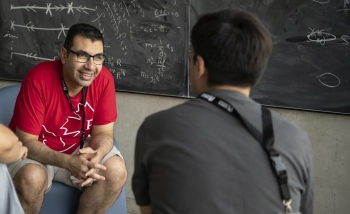
Perimeter Hosts Strings 2023: Spotlighting new directions and uniting a community
September 22, 2023
